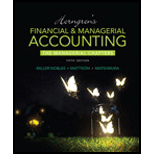
Concept explainers
1.
Special Journal: It is a book where only specific type of monetary transactions such as cash receipts, cash payments, credit sales, and credit purchases are recorded.
Sales Journal: It is a special book where only sales transactions that are sold to customer on credit are recorded.
Purchase Journal: It is a special book where only purchase transactions that are purchased from suppliers on credit are recorded.
Cash Receipts Journal: It is a special book where only cash receipts transactions that are received from customers or other sources are recorded.
Cash Payments Journal: It is a special book where only cash payments transactions that are paid to the supplier or other sources are recorded.
General Journal: It is a book where all the monetary transactions are recorded in the form of
To record: The transactions in a sales journal.
2.
To calculate: Total each column of the sales journal.
3.
To show: How posting would be made by writing the accounts numbers and check marks in the journals.
Want to see the full answer?
Check out a sample textbook solution
Chapter C Solutions
Horngren's Financial & Managerial Accounting, The Managerial Chapters (5th Edition)
- Please help me with this problem!arrow_forwardPlease help me with this problemarrow_forwardPROBLEM 2 On July 1, 2022, LTU Contracting, Inc. purchased a new Peiner SK575 Tower Crane for a total cost of $875,000. The crane has an estimated useful life of five (5) years. For financial reporting (book) purposes, the company utilizes straight line depreciation. For tax purposes, the equipment is depreciated over five years utilizing the 200% declining balance method. A. Prepare a table that computes the book and tax depreciation for each year of the useful life and determine the difference in book value between each method at the end of each year. B. On July 1st, 2025, the company is considering selling the crane for $500,000. Compute what the gain or loss would have been at that time for both book and tax purposes.arrow_forward
 Financial AccountingAccountingISBN:9781305088436Author:Carl Warren, Jim Reeve, Jonathan DuchacPublisher:Cengage Learning
Financial AccountingAccountingISBN:9781305088436Author:Carl Warren, Jim Reeve, Jonathan DuchacPublisher:Cengage Learning College Accounting (Book Only): A Career ApproachAccountingISBN:9781337280570Author:Scott, Cathy J.Publisher:South-Western College Pub
College Accounting (Book Only): A Career ApproachAccountingISBN:9781337280570Author:Scott, Cathy J.Publisher:South-Western College Pub- Century 21 Accounting Multicolumn JournalAccountingISBN:9781337679503Author:GilbertsonPublisher:Cengage
 College Accounting, Chapters 1-27AccountingISBN:9781337794756Author:HEINTZ, James A.Publisher:Cengage Learning,Principles of Accounting Volume 1AccountingISBN:9781947172685Author:OpenStaxPublisher:OpenStax College
College Accounting, Chapters 1-27AccountingISBN:9781337794756Author:HEINTZ, James A.Publisher:Cengage Learning,Principles of Accounting Volume 1AccountingISBN:9781947172685Author:OpenStaxPublisher:OpenStax College





